Click the Civic hybrid for a high-res gallery
Toyota may have been the first automaker to bring a mass produced gas-electric hybrid to market overall, but Honda was the first to hit the road in the US with the Insight in late 1999. The insight wasn't a huge commercial success for many of the same reasons that the GM EV1 likely wouldn't have been even if GM had opened it up to everyone. The two-seat Insight was small, had limited cargo capacity, was expensive to build and had limited appeal for American tastes at the dawn of the 21st century. While the Insight's package wasn't a retail success, Honda took the Integrated Motor Assist (IMA) hybrid system and dropped it into the Civic sedan beginning in 2002. A new generation Civic with a corresponding hybrid model debuted for the 2006 model year carrying over the IMA system. While the Civic hybrid hasn't had anywhere near the sales of the Prius, it does remain the third best selling hybrid behind the hybrid icon and the Camry hybrid. AutoblogGreen spent a week driving the Civic hybrid recently and you can read all about it after the jump.
Toyota may have been the first automaker to bring a mass produced gas-electric hybrid to market overall, but Honda was the first to hit the road in the US with the Insight in late 1999. The insight wasn't a huge commercial success for many of the same reasons that the GM EV1 likely wouldn't have been even if GM had opened it up to everyone. The two-seat Insight was small, had limited cargo capacity, was expensive to build and had limited appeal for American tastes at the dawn of the 21st century. While the Insight's package wasn't a retail success, Honda took the Integrated Motor Assist (IMA) hybrid system and dropped it into the Civic sedan beginning in 2002. A new generation Civic with a corresponding hybrid model debuted for the 2006 model year carrying over the IMA system. While the Civic hybrid hasn't had anywhere near the sales of the Prius, it does remain the third best selling hybrid behind the hybrid icon and the Camry hybrid. AutoblogGreen spent a week driving the Civic hybrid recently and you can read all about it after the jump.
Photos Copyright ©2008 Sam Abuelsamid / Weblogs, Inc.
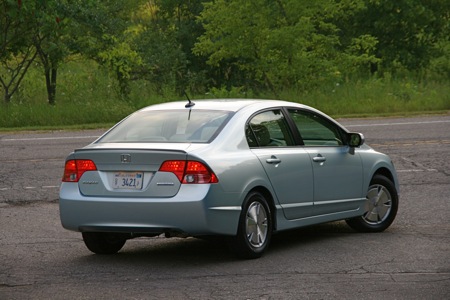
The original Honda Civic first rolled onto the streets in 1973 and the current eighth generation model is the biggest one yet. By no means is the Civic a large car by modern standards but today's Civic is significantly larger than the first Accords were in the 1970s. This is the first generation in the history of the Civic that hasn't been available in hatchback form (at least in North America). These days the Civic is now only available in four door sedan and two door coupe forms and the hybrid setup can only be had in the former. While the last couple of generations had pretty sedate styling, the newest sedan has proved controversial both on the inside and outside.
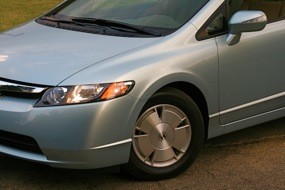
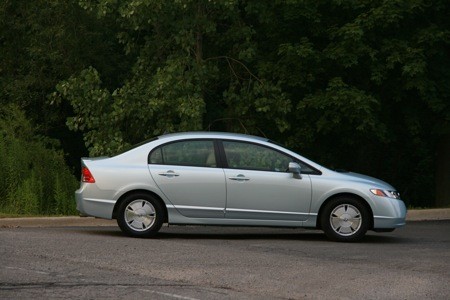
Perhaps more controversial than the body of the latest Civic has been the dash board layout. The gauges have been split into a double decker layout with the normal pod visible through the steering wheel containing a tachometer and energy meter along with the PRNDL display. A second pod sitting on top of the dash features a digital speedometer, fuel gauge and instantaneous fuel economy. Although I've never personally been a fan of digital speedometers, this setup actually works reasonably well. At least Honda has acknowledged that the the instruments belong directly in front of the driver and not sitting off in the middle of the dashboard somewhere.
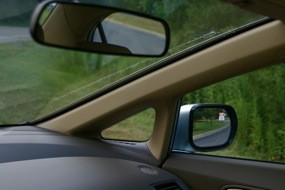

What the Fit doesn't offer (at least for a couple more years anyway) is a hybrid powertrain. Unlike Toyota's Hybrid Synergy Drive, IMA is a mild hybrid system, although not nearly as mild as GM's BAS system. The thin 20hp brush-less DC motor is sandwiched between the 1.3L four cylinder engine and the electronically variable transmission. While systems from Toyota, Ford and GM can decouple the motor from the engine allowing pure electric drive with no engine motion, the Honda system is always turning the engine. As the name implies, the motor is primarily to used to provide some power assist to the engine under acceleration and recapture kinetic energy during braking. While the motor doesn't accelerate the car on its own, during light load driving the fuel supply can be shut off allowing the motor to propel the car (and turn over the un-fueled engine) on its own. Electrical energy is stored in a 158V nickel metal hydride battery pack.
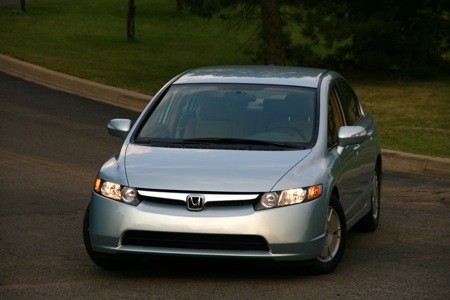
The 2006 Civic hybrid was the first Honda to feature blending of the friction and regenerative braking. Previous editions overlaid the regen braking on top of the normal friction brakes. The blending capability reduces brake pressure when the battery has some capacity to store electrical energy allowing for more regen and less wear on the brakes. The system generally works smoothly although there is a noticeable drop off in deceleration at about 7 mph when the regenerative braking is ramped out. At that point the friction brake pressure isn't restored quickly enough to maintain deceleration. While a driver will get used to this loss of deceleration it can be a bit disconcerting at first and could pose a problem in tight stop and go traffic if the driver isn't careful.
While the engine gets some torque boost from the electric motor, the Civic hybrid is probably not the car for fans of the Civic Si. Like other Honda four cylinders this one is a smooth runner and the auto restart is quick and shudder free. What it isn't is quick. Acceleration is comparatively leisurely. It's not dangerously slow by any means and gets up to speed merging onto highways without drama, either positively or negatively. Similarly, the handling is adequate. The basic layout provides neutral and stable responses with good ride quality. The problem is that the low rolling resistance tires are also low in grip. You don't have to go around a corner very quickly before the tires start sliding and letting you know audibly that they are no longer capable of generating more lateral force.
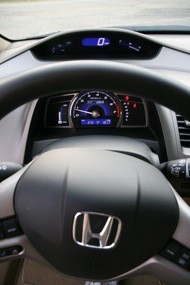
Even with the added loads, the Civic still managed to achieve 37 mpg in a week of real world driving, most of which was around town. That certainly puts it near the top of the heap of what's currently available in the US. The Civic Hybrid starts at $22,600 which puts it at $1,100 more than the base price of a Prius. Or tester had the nav system package which brings the opening price to $25,020 including delivery. The Civic doesn't offer stability control while the Prius does. Because the Civic and Prius only offer options in fixed packages it's hard to get a direct apples to apples comparison of cost. Let's just say it's about a wash.
You could pick either one and get a very fuel efficient car. In fact as you get beyond about 35 mpg, the total annual fuel consumption differences start to become increasingly small. At $4 /gallon, going from 37 to 42 mpg only amounts to $156 difference in fuel cost over 12,000 miles. So it really comes down to which car do you prefer the looks of and perhaps more importantly right now, which can you actually get your mitts on? Civics and Priuses are both in extremely short supply right now as are most other smaller higher mileage cars. Getting either one is likely to mean a wait of several weeks to several months.
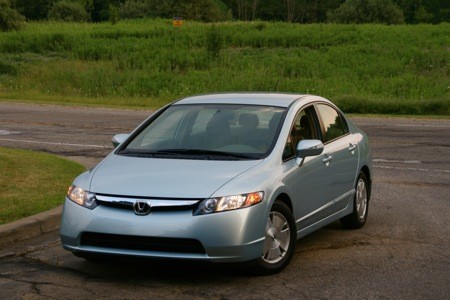
Photos Copyright ©2008 Sam Abuelsamid / Weblogs, Inc.

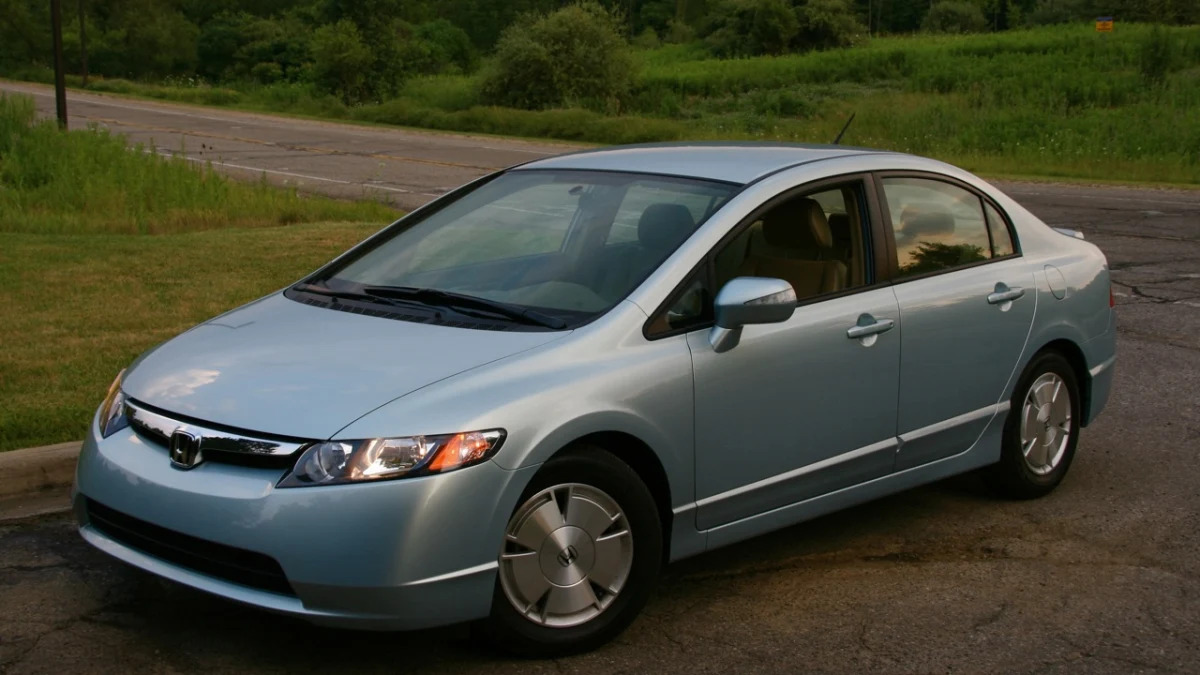

Sign in to post
Please sign in to leave a comment.
Continue